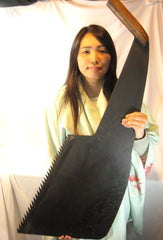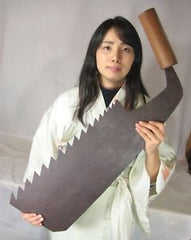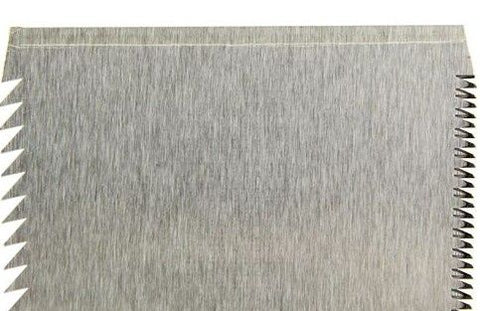Welcome to Part 3 of our Japanese Woodworking Tools Blog Series.
In this entry, I humbly attempt to demystify Japanese Hand Saws.



The Japanese Pull Style Saw or Nokogiri, has in the past twenty to thirty years become an accepted and remarkably popular hand tool in Western Woodworking.
Building Without Nails - The Genius of Japanese Carpentry from Adde on Vimeo.
The first woodworking saws to be imported into Japan more than likely came from China via Korea, many centuries ago. Very soon after the introduction of these saws into Japan, the teeth were angled to enable the saws to cut on the pull stroke. Unfortunately, the reasons as to why this modification occurred has not been historically documented, but it must have been a logical and sensible adaptation at the time.

In ancient Japan, the Shokunin typically worked in a squatting or a sitting position. Even today, many Japanese craftsmen practise their craft seated on a simple mat on the floor.
Bearing this in mind, if you try to use a typical Western Saw whilst seated on the floor, you are unable to use your body weight and arm muscles for power to push the saw. On the other hand, a Pull Style Saw (cutting on the opposite/return stroke) is far more efficient in the seated or kneeling position, as you can use the muscles of your entire body to make the cut, without having to depend on your body weight.
If you think about it, you use Western fret saws, Coping Saws and Cabinetmaking Bow Saws on the pull stroke with the teeth facing towards you, thus keeping the blade in extension and taut whilst executing the cut, so understanding and learning to work with Japanese style saws is actually very easy!

Japanese Craftsman at Work, circa 1870
Early Japanese sawyers realised the need to have dedicated saws for each type of work and timber, therefore they filed the teeth for cross-cutting or rip-cutting and within these tooth patterns, heavy cutting or delicate fine cutting.

The Japanese woodworker typically works in indigenous softwoods. The better quality softwood timbers used are (sugi) Cedar and (hinoki) Cypress.

A Beautiful Display of the Most Used Timbers in Japanese Woodworking
Japanese Rip Saws for hardwoods have a greater gullet angle than the Rip Saws for softwoods, which have more acute points to the teeth, but otherwise the chisel-cut style teeth are similar to Western Saws. Japanese Cross-Cut Saws for hardwoods have a less acute bevel angle on the teeth.

It is very interesting to note that Japanese saws are not graded according to their teeth per inch (tpi), a system that we are familiar with in our Western style woodworking. Instead, teeth are sized and graded for each specific blade length, so Japanese saws are defined by the intended application of the hand saw and length of the blade, for example a Kataba-Nokogiri 270mm, describes the type of saw, indicates it's application and blade length.
Japanese Rip Saws have smaller teeth at the heel of the saw and larger teeth at the toe. The cut is started with the teeth at the heel and once the initial kerf is established, you then move your working area up the saw to utilise the larger teeth achieve a fast and energy efficient cut.
So now that we know a little more about the history, format and function of Japanese woodworking saws, we can define them by type and application:

The Ryoba-Nokogiri
The most useful Japanese Hand Saw is the Ryoba, a double-edged saw with rip teeth on one side and crosscut teeth on the other.

Ryoba-Nokogiri Teeth Configuration
It is quite often difficult to start a rip cut, especially for a novice, but using a ryoba allows you to define the start of the cut with the crosscut teeth and then turn the saw over and continue with the rip cut teeth. The fact that this saw has both types of teeth means that if push comes to shove, you can cut all your joints with just this one saw.

The Dozuki-Nokogiri
The next most useful saw is the Dozuki, a word which actually means tenon.
The Dozuki-Nokogiri is the most widely adopted Japanese hand saw in Western woodworking.The Dozuki is used to cut extremely accurate shoulder lines on woodworking joints. The teeth of the Dozuki are very small and these saws have a back spine which supports the saw blade along it's length, just like their Western counterparts.

By virtue of having a spine, and with the saw cutting on the pull stroke (in extension as opposed to in compression), the Dozuki can have a much thinner blade, resulting in very fine saw kerfs that require little or no post-cut clean up at all.

The Kataba-Nokogiri
Just like a Western Tenon Saw, the Dozuki will only cut to the depth of the blade below the spine, so it is important to also own a Kataba which is a spineless cross cut saw. Kataba saws quite often also have a graduated tooth pattern to enable easy starting of your saw kerf.
Without a spine, utilising a thicker blade than a Dozuki and with a single tooth row, the Kataba is a wonderful general-purpose saw and a is very common saw in many Western woodwork workshops.
Many Japanese woodworking joints require angled cutting that is not at 90º to the grain line. For this type of work, a saw with ibara-me or nezumi-ba teeth is used. These teeth are part cross-cut and part rip-cut and give an exceptionally fast cut.

The Kugihiki-Nokogiri
In Japanese, Kugihiki means to "cut nails". This is not a reference to the steel things that "woodbutchers" use to assemble cabinetry, but rather refers to the wooden dowels and bamboo nails that are widely used in Japanese woodworking. Kugihiki-Nokogiri feature a blade with teeth that have no set at all and are designed for flush-cutting these wooden nails and dowels without damaging the surface which they are inserted into.
The Kugihiki-Nokogiri blade is often thinner at the tip for easy bending and to enable accurate finessing of the cut. The blade is also fractionally thicker at the rear for better stability when cuts are more aggressive.
Japanese Hand Saws that are lesser known in the West:

The Azebiki-Nokogiri
These saws are most often found in the Ryoba style and have a short, curved blade with teeth on each side. This saw is typically used for starting a cut in the centre of a panel. The short blade also allows easy access into tight or awkward areas.
The Sokomawashibiki-Nokogiri
The Japanese word "Sokomawashibiki" translates loosely as "bottom".
These are curve cutting saws, originally used for cutting the bottoms for wooden buckets. The curvature of the blade facilitates cutting a curved profile and can be used for both hardwoods and softwoods.
The Anahiki-Nokogiri
Anahiki saws are used for log or beam cutting in both green and seasoned woods. Typically, these saws are used for general construction or timber framing, but they can be put to excellent duty in the workshop for rough-cutting of rough-sawn hardwood or softwood lumber.
The Mawashibiki-Nokogiri
Translated, mawashibiki means "Turning Cut".
These saws feature narrow thick blades that excel at cutting tight curved and keyholes.
There are a number of excellent books available on Japanese Tools and Woodworking. I am grateful to the remarkable knowledge of Toshio Odate and his book "Japanese Woodworking Tools - Their Tradition, Spirit and Use" amongst a few other resources in the compilation of our Japanese Woodworking Tools Blog Series.
In Part 4, Japanese Chisels will be our topic of discussion.
Until next time, let's make shavings, not dust!



















Comments
Leave a comment